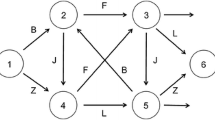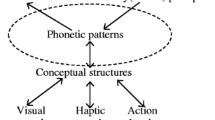Abstract
Adult subjects attempted to identify structures (words and constituents) in sentences of a language they did not know. They heard each sentence twice-once with a pause interrupting a structural component and once with a pause separating different structural components. They were asked to choose the version that sounded more natural. An experimental group of subjects who had been previously exposed to a spoken passage in the same language as the test sentences was more successful in identifying structures of the sentences than was the control group with previous exposure to another language. This result was interpreted as demonstrating that language structure may be partially acquired during a brief exposure without reliance on meaning. It was also noted that the experimental group identified constituents more accurately than words. This result suggested that constituents, more than words, function as acquisitional units of language.
Similar content being viewed by others
References
Bond, Z. S., and Gray, J. (1973). Subjective phrase structure: An empirical investigation.J. Psycholing. Res. 2: 259–266.
Brown, R. (1973). Development of the first language in the human species.Am. Psychologist 28: 97–106.
Brown, R., Cazden, C., and Bellugi, U. (1968). The child's grammar from I to III. In Hill, J. P. (ed.),Minnesota Symposia on Child Psychology, Vol. 2, University of Minnesota Press, Minneapolis, pp. 28–73.
Fodor, J. A., and Bever, T. G. (1965). The psychological reality of linguistic segments.J. Verbal Learn. Verbal Behav. 4: 414–421.
Hayes, J. R., and Clark, H. H. (1970). Experiments on the segmentation of an artificial speech analogue. In Hayes, J. R. (ed.),Cognition and the Development of Language, Wiley, New York, pp. 221–234.
Macnamara, J. (1972). Cognitive basis of language learning in infants.Psychol. Rev. 79: 1–13.
Martin, E. (1970). Toward an analysis of subjective phrase structure.Psychol. Bull. 74: 153–166.
Martin, J. E., Kolodziej, B., and Genay, J. (1971). Segmentation of sentences into phonological phrases as a function of constituent length.J. Verbal Learn. Verbal Behav. 10: 226–233.
Neisser, U. (1967).Cognitive Psychology, Appleton-Century-Crofts, New York.
Osgood, C. E., and Sebeok, T. A. (1965).Psycholinguistics: A Survey of Theory and Research Problems, Indiana University Press, Bloomington, Ind.
Skinner, B. F. (1957).Verbal Behavior, Appleton-Century-Crofts, New York.
Wakefield, J. A., Jr., Bradley, P. E., Yom, B. L., and Doughtie, E. B. (1975). Language switching and constituent structure.Lang. Speech (in press).
Winer, B. J. (1962).Statistical Principles in Experimental Design, McGraw-Hill, New York.
Author information
Authors and Affiliations
Rights and permissions
About this article
Cite this article
Wakefield, J.A., Doughtie, E.B. & Lee Yom, BH. The identification of structural components of an unknown language. J Psycholinguist Res 3, 261–269 (1974). https://doi.org/10.1007/BF01069242
Received:
Issue Date:
DOI: https://doi.org/10.1007/BF01069242




